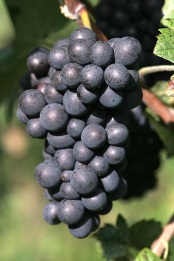The pinot meunier variety
History
Pinot meunier
is the second most important vine variety in the Champagne region. It represents 32% of the vineyards. Like
pinot noir
, this vine variety has black grapes and white pulp. It gets its name from the downy layer covering the underside of the leaf as though it were covered in flour. This cepage has had a more modest development due to its coarseness. Indeed, it was not used very much until recent times. It was only from the middle of the 19
th
century onwards that the first wine companies (such as Chanoine) started planting these vines systematically. It has mingled easily with blendings to become nowadays the major element in certain cuvees.
Historically, this cepage was first mentioned in the 16 th century. But the first written record in a farmer’s handbook appears only in the 17 th century.

Characteristics
Pinot meunier owed its recent success to the fact that it resists harsher climatic conditions than pinot noir. Its late
bud break
protects it for most of the time from the very destructive
spring frost
. Furthermore this vine variety resists severe winter cold which has made it particularly popular and suitable for planting on northern facing slopes or at the bottom of hillsides, where frost is most frequent.
Pinot meunier is not at home in poor soil lacking in moisture. It thrives in siliceous or clayey-siliceous soil and is not at all adapted to overly chalky soil. That is why it is found mainly in Vallée de la Marne , the Massif of Saint Thierry and hardly ever, for example, in Côte des Blancs or Côte des Bar .
Its vegetative cycle lasts for about 170 days from the first buds to maturity. Its flowering is slightly later than that of pinot noir, which causes it to be more easily affected by coulure and millerandage .
The clusters are very compact and the berries very close to one another, therefore during rainy periods, the water has trouble running out and may even stagnate. Stagnation as well as a fairly mild temperature creates ideal conditions for fungal diseases such as powdery mildew , downy mildew or grey rot .
In addition, like pinot noir, pinot meunier is an easy target for pyralids or cocchylis moths .
Vinification
Although it is rarely vinified on its own, pinot meunier produces wines which are undoubtedly less fine and nervy than pinot noir. In addition, one of its typical features it to sometimes lacking in acidity during its development and it ages more quickly. However, when blending, the freshness of the young wine provides this extra vibrancy which may possibly be lacking in hot years. Its greatest quality nevertheless remains its fruity taste giving off aromas of white fruit (apple, pear), citrus fruits or read berries.
References

